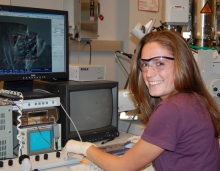
Major:
University:
Mentor(s):
Faculty Sponsor(s):
Faculty Sponsor's Department(s):
Project Title:
Project Description:
General Electric’s René N5 single crystal nickel-based superalloy is used in land based gas turbine engines where use temperatures can reach up to1200°C, or 90% of the alloy’s melting temperature. Two variants of single crystals were evaluated, made either with liquid-metal cooling (LMC) or gas-cooling casting processes (GCC), and these then underwent sustained peak low cycle fatigue (SPLCF) at 1200°F, 1400°F, and 1800°F. SPLCF is a strain controlled test that involves cyclic loading: a sample is loaded within 1.5 seconds, held for 2 minutes, and unloaded within 1.5 seconds repeatedly. Fracture surface analyses, primary and secondary dendrite arm spacing, porosity, and chemical composition were measured to assess common reasons of failure and to examine the differences between the LMC and GCC processes. LMC and GCC both use convection as a means for heat withdrawal, but liquid metal (usually tin) is the cold face for LMC while GCC uses an inert gas. The higher rate of heat transfer for the LMC single crystals is expected to yield better structural properties than GCC single crystals as a result of a smaller dendrite arm spacing, smaller pore sizes, and more uniform chemical compositions. However, we found a noticeably larger fraction of carbides and pores in the René N5 LMC single crystals that caused them to fail prematurely. The results from this work will guide GE to make necessary adjustments to their single crystal casting procedures to provide safer and more efficient gas turbine engines.
